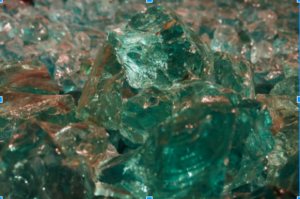
The volcano of Kawah Ijen, situated on the island of Java, is known for two distinctive geological phenomena. It is a shallow volcanic crater emitting hot and combustible sulfurous gases. These gases burst into electric blue flames when they enter Earth’s atmosphere due to the abundance of oxygen. A portion of the emitting gases also gets condensed in the atmosphere to take the shape of molten sulfur. The blue ambiance created by burning sulfur produces a striking view, especially at night.
The second geological phenomenon is a one-kilometer wide caldera lake of turquoise blue water. This unusual color of the water is due to high acidity and high concentration of dissolved metals in the reservoir.
This caldera reservoir is the most acidic lake with a measured pH of as low as 0.3. These high levels of acidity are caused due to the fact that hydrothermal waters inflowing in the lake is charged with gases from a hot magma chamber.
History of the Volcano
According to geological findings, volcanic activity in the area began 300,000 years ago with the buildup of a humongous stratovolcano which is now known as Old Ijen. A stratovolcano is a high, conical buildup of layers of hardened lava and volcanic ash. The volcano grew to the height of about 1000 feet over thousands of years with repeated eruptions.
The caldera lake was formed about 50,000 years ago with a cascade of intense volcanic eruption. During the last 50000 years, many small stratovolcanoes within this Caldera including Kawah Ijen have been formed. Kawah Ijen is located in the eastern part of the Caldera.
The volcano is still active but hasn’t experienced magmatic eruptions since 1817. However phreatic eruptions have been happening till today. The last phreatic activity occurred as recently as 2011.
Lake Also Produces Sulfur Deposits
The opening of the volcano at the lake-side produces a continuous stream of sulfur enriched gases. These gases usually flow underground in the absence of oxygen. If the gas is hot enough at the time of eruption, then sulfur will ignite into blue flames, but usually, the temperature of the mixture is not that high, which results in the condensation of molten sulfur when it comes out on the surface. This molten sulfur then travels a short distance before ending up in solidified form. Local people collect those deposits of sulfur and sell them to a local sugar refinery.
Kawah Ijen Volcano: One of the Few Sites of Artisanal Mining in the World
Most of the sulfur produced around the world is the byproduct of natural gas processing and oil refining. This site is one of the few ones where sulfur was mined, even though the process is a dangerous one. Miners have to walk up to the top of the mountain and then descend down the dangerously steep and rocky paths of the crater. They use metal objects; usually steel bars to break solidified sulfur from the outcrops. They fill up their baskets with soft sulfur rocks travel back to the sugar refinery. Miners are paid according to the weight of the sulfur.
Recently, miners have installed numerous pipes along the mountain. This network of pipes is created to collect the sulfur-laden gases from various vents and openings of the volcano and direct them to those areas from where gathering sulfur deposits is easy. This development has made the process of collection more efficient and less harmful for the miners.
Kawah Ijen Volcano: A Tourist Site
Many adventurous people have made this place a tourist site. The area around possesses a beautiful landscape with fauna that can only flourish in these highlands. With an elevation of more than 2,000 meters, atmospheric temperature around the volcano is usually low. The fusion of different air temperatures — cold ambient air merging with the heat escaping from the volcanic openings, creates a very peculiar sensation that can’t be felt anywhere else.
A moderate 3-km track, which traverses through Casuarinas forest, leads up to the volcanic rim. From here the journey gets arduous with 2 km more of a relatively steep trail and ends up giving you a breathtaking panoramic view of Ijen Caldera. A slightly pungent smell of sulfur fumes rising from the acid lake will welcome you. For safety purposes, it is better to wear a gas mask.













